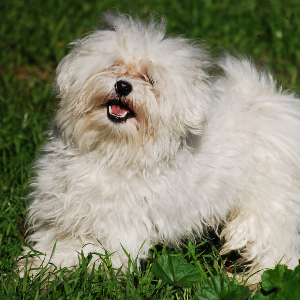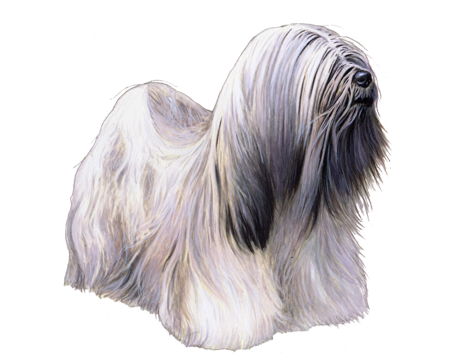
Bolognese
The Bolognese is a little dog with a lot of fans. A calm breed that requires little exercise, the Bolo makes an easygoing and playful companion. With their long, frizzy white hair, these pups are as adorable as they are affectionate and devoted.
Interested in discovering if your dog is a Bolognese?
Check out Wisdom Panel's DNA tests.

Bolognese Traits
General Appearance
The Bolognese is a small, stocky dog with a square build, serene expression, noble carriage, and long, fluffy white coat.
Coat and Colouring
A long, frizzy (but incredibly soft), white coat gives the Bolo a slightly unkempt appearance. The hair from head to tail is long and stands off the body, whereas the hair on the muzzle is shorter. Under the breed standard, the ideal coat color is pure white. But light shades of ivory are possible.
Distinctive Physical Traits
The Bolognese is as long as it is tall. The breed has a square build, high set ears that are long and hanging (making its head look oversized), and a long tail carried over the back.
Bolognese Temperament
Bolognese dogs have calm, easygoing natures. They're affectionate and enjoy spending time with their owners. The strong bond Bolos have with their people make them an excellent breed for retirees or people who stay home most of the time. Bolos are also prone to separation anxiety, so they shouldn't be left alone for long periods. Otherwise, they may become anxious and stressed.
Bolognese dogs often get along well with children, provided adults supervise. But keep in mind that young kids may be too excitable when playing with a little dog like the Bolo. Also, this breed sometimes develops small dog syndrome and may not appreciate the enthusiastic affections of little ones.
A calm demeanor makes the Bolognese an excellent traveling companion and well-suited to apartment living. Bolos aren't excessive barkers. Still, they're vigilant dogs and will alert their owners if something is amiss.
Though they are happy, social, and affectionate with their families, Bolognese dogs tend to be shy around strangers. But with proper socialization, they warm up quickly.


Bolognese History
As its name implies, the Bolognese comes from Bologna, Italy. This toy breed belongs to the Bichon family and is sometimes called the Bichon Bolognese. Bolos have been popular with aristocratic families since the 11th century.
In Roman times, Bolognese dogs were popular gifts among those with great wealth and power. For example, King Umberto of Italy gifted a Bolognese to a Belgian princess for her birthday. And Duke Alfonso II d'Este of Ferrara gave a pair of Bolos to King Phillip II of Spain. The list goes on.
Other famous Bolo owners include Catherine the Great of Russia and Marilyn Monroe. And depictions of the breed appear in historical works of art, such as a Flemish tapestry dating back to the 17th century.
Despite this early popularity, the breed fell out of favor and nearly became extinct. But thanks to the efforts of a small group of European breeders, the Bolognese's numbers are up again.
Bolognese Care
Nutrition
Bolos need a high-quality dog food that matches their life stage (e.g., puppy, adult, senior). Also, consider a diet specially formulated for small breeds.
Extra calories can add up quickly for a small dog, and that can lead to obesity. To help your Bolognese maintain a healthy weight, monitor their food intake carefully, measure out meals to avoid overfeeding, and limit treats to no more than 10% of their daily calories.
Grooming
The Bolognese is a non-shedding breed. But brushing helps remove debris from these dogs' long coats and prevents matting. And occasional baths will keep their coats clean and healthy. Though they don't require haircuts, some people choose to keep their Bolo's coat shorter and leave an untrimmed "mop" on top.
Trimming nails, cleaning ears, and brushing teeth should also be part of your Bolo's grooming routine.
Exercise
The Bolognese doesn't require a lot of exercise. A short walk around the block is all it takes to tucker the breed out. Though these dogs might not need much physical activity, they're playful and curious canines. So, they enjoy exploring in a fenced yard, playing games like hide-and-seek, chasing balls, and learning new tricks—especially if it means spending time with their owners.
Training
Bolognese dogs are highly intelligent and eager-to-please, which makes them a breeze to train. Obedience training sessions are great opportunities to teach your Bolo the basics—such as come, sit, and stay—while enhancing your bond.
Because this breed is prone to small dog syndrome, your Bolognese might try to take on the role of pack leader. And such behavior sometimes makes separation anxiety or extreme shyness more likely. Training can help Bolos feel more confident, leading to happier, more well-adjusted dogs.
Since Bolognese dogs tend to be timid around strangers, early socialization is also important. Formal classes provide opportunities for Bolos to interact with other dogs and their owners. Another option for creating positive encounters is to bring this happy-go-lucky breed along on errands or vacations.

Breed Group
Companion
This group consists of dogs typically bred for the specific purpose of human companionship, and many are popular pets because of their gentle nature. They became more common as the concept and luxury of dogs as pets prevailed.



























_Color.png)










